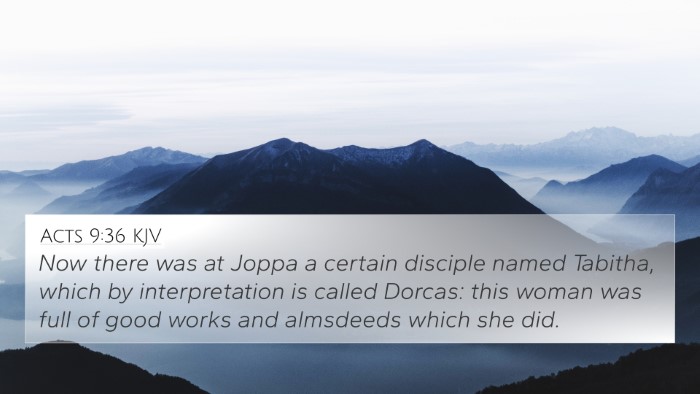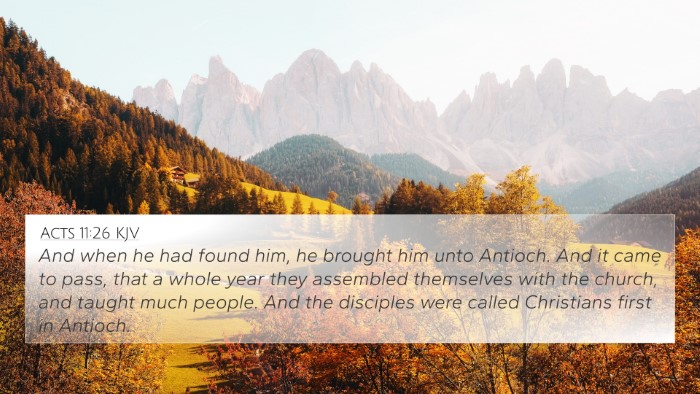Understanding Acts 9:38
The passage Acts 9:38 recounts the story surrounding the death of a woman named Tabitha (also known as Dorcas) who was beloved in the community for her good works and acts of charity. Her death brought grief to those who knew her, particularly in Joppa, where she lived. The text reflects themes of compassion, community, and the power of God through the apostles.
Contextual Analysis
In Acts 9, the Apostle Peter is depicted in a crucial moment where he is called to perform a miraculous act of resurrection. This not only reveals Peter's role as a leader in the early church but also emphasizes the divine authority granted to him through the Holy Spirit. The need for such a miracle illustrates the faith of the early Christian community and their understanding of the power of Jesus' name.
Commentary Insights
Matthew Henry's Commentary
Matthew Henry emphasizes the significance of Tabitha's life. He highlights her good deeds and how her passing led to deep sorrow among the widows she had helped. Henry notes that her resurrection not only restored her to life but also served as a testimony to the power of Christ working through Peter, encouraging the faith of those who witnessed it.
Albert Barnes' Commentary
Albert Barnes points out the practical impact of Tabitha's character in the community. He notes that her acts of charity were integral in articulating the principles of Christian love and service. Barnes also discusses the cultural context, suggesting that her resurrection was a significant confirmation of Peter’s apostolic authority, further validating the gospel message in Joppa.
Adam Clarke's Commentary
Adam Clarke highlights the honor shown to Tabitha by the community, which showcases the importance of individuals in the early church. He focuses on the response to her death and the fervent prayers offered up for her restoration. Clarke's analysis notes the miracle not just as an act of compassion but also as an evangelistic tool to spread the teachings of Christ's resurrection.
Bible Verse Cross-References
- Matthew 5:16 - This verse speaks about letting one's light shine before others through good works, paralleling Tabitha's life.
- Acts 10:1-2 - The story of Cornelius highlights an individual prepared for divine visitation, much like Tabitha's situation.
- John 11:1-44 - The resurrection of Lazarus demonstrates similar themes of grief and divine intervention.
- James 2:14-17 - Emphasizes faith being demonstrated through works, a principle evident in Tabitha’s life.
- 2 Corinthians 1:24 - Paul affirms the importance of standing firm in faith and the encouragement leaders can provide.
- John 14:12 - Jesus states that those who believe in Him will do greater works, highlighting apostolic ministry power.
- Galatians 6:10 - Encourages doing good to all, reinforcing the message of community care as seen in Tabitha.
- Acts 3:6 - Peter's healing miracles indicate the power he wielded through Christ’s name, similar to the event with Tabitha.
- Hebrews 11:32-34 - Mentions the faithful who received back their dead, tying into resurrection themes present in Acts 9:38.
- Romans 12:10 - Calls believers to be devoted to one another in brotherly love, reflective of Tabitha’s relationships.
Thematic Connections
This verse and its surrounding narrative offer rich themes interwoven throughout scripture:
- Compassion and Service: Reflects the essence of Christian living as seen in many other Scriptures, establishing a strong case for community service.
- Faith in Action: Illustrates how faith manifests through deeds, drawing parallels across both Old and New Testament teachings.
- Miraculous Works: The importance of miracles in authenticating the message of the gospel, linking to Christ's own ministry.
- Resurrection and Hope: A significant aspect that connects believers to the promise of eternal life, seen throughout scripture.
Cross-Referencing Biblical Texts
Acts 9:38 serves as an excellent verse for those wanting to engage in cross-referencing Biblical texts. By studying related verses, one can deepen their understanding of the interconnectedness of scriptural themes and the nature of God's work among His people.
To fully appreciate Acts 9:38, it can be beneficial to employ tools for Bible cross-referencing such as a Bible concordance or a cross-reference Bible study guide. Many resources outline how to navigate scripture to find valuable connections.
Conclusion
In conclusion, Acts 9:38 encapsulates a poignant moment in the early church that speaks volumes about community, faith, and the miraculous power of God. The insights from various commentaries provide a foundation for understanding how this passage interacts with other scriptures. Engaging with Bible verses that relate to each other gives believers a richer tapestry of understanding and a deeper appreciation for the Biblical narrative.






